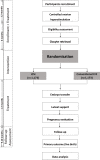Intracytoplasmic sperm injection (ICSI) versus conventional in vitro fertilisation (IVF) in couples with non-severe male infertility (NSMI-ICSI): protocol for a multicentre randomised controlled trial
- PMID: 31575574
- PMCID: PMC6773417
- DOI: 10.1136/bmjopen-2019-030366
Intracytoplasmic sperm injection (ICSI) versus conventional in vitro fertilisation (IVF) in couples with non-severe male infertility (NSMI-ICSI): protocol for a multicentre randomised controlled trial
Abstract
Introduction: Intracytoplasmic sperm injection (ICSI), originally introduced as add-on to in vitro fertilisation (IVF) for couples with severe male infertility, is in current clinical practice also used in couples with mild male or even unexplained infertility. However, ICSI has involved unresolved concerns regarding the selection and damage to gametes and the health conditions of the offspring, and it is also labour intensive and therefore more expensive than conventional IVF. High-quality well-powered randomised clinical trials (RCTs) comparing ICSI and IVF are lacking.
Methods and analysis: We propose a multicentre, open-label RCT in 10 reproductive medical centres across China. We will study couples with non-severe male infertility (defined as a semen concentrate 5-15×106/mL or sperm with a progressive motility 10%-32%) scheduled for their first or second ICSI or IVF cycle, as low fertility rate after fertilisation are more frequent in this population, which could lead to controversy about ICSI or conventional IVF for fertilisation. On the day of oocyte retrieval, eligible participants are after informed consent be randomised to undergo either ICSI or conventional IVF in a 1:1 treatment ratio. Other standard assisted reproductive treatments are similar and parallel between two groups. Our primary outcome is ongoing pregnancy leading to live birth after the first cycle with embryo transfer. To demonstrate or refute a difference of 7% between ICSI and conventional IVF, we need to include 2346 women (1173 in each intervention arm). In addition, we will follow-up neonatal outcomes after delivery to identify the influence of ICSI on offspring.
Ethics and dissemination: Ethical approval was obtained from Peking University Third Hospital medical science research ethics committee. The findings will be disseminated to the public through conference presentations and peer-reviewed scientific journals.
Trial registration number: ClinicalTrials.gov registry (NCT03298633).
Keywords: assisted reproductive technology; in vitro fertilisation; intracytoplasmic sperm injection; non-severe male infertility.
© Author(s) (or their employer(s)) 2019. Re-use permitted under CC BY-NC. No commercial re-use. See rights and permissions. Published by BMJ.
Conflict of interest statement
Competing interests: None declared.
Figures
Similar articles
-
Intracytoplasmic sperm injection versus conventional in-vitro fertilisation for couples with infertility with non-severe male factor: a multicentre, open-label, randomised controlled trial.Lancet. 2024 Mar 9;403(10430):924-934. doi: 10.1016/S0140-6736(23)02416-9. Epub 2024 Feb 5. Lancet. 2024. PMID: 38330980 Clinical Trial.
-
In vitro fertilisation (IVF) versus intracytoplasmic sperm injection (ICSI) in patients without severe male factor infertility: study protocol for the randomised, controlled, multicentre trial INVICSI.BMJ Open. 2021 Jun 24;11(6):e051058. doi: 10.1136/bmjopen-2021-051058. BMJ Open. 2021. PMID: 34168037 Free PMC article.
-
Preimplantation genetic testing for aneuploidy in severe male factor infertility: protocol for a multicenter randomised controlled trial.BMJ Open. 2022 Jul 13;12(7):e063030. doi: 10.1136/bmjopen-2022-063030. BMJ Open. 2022. PMID: 35831058 Free PMC article.
-
Regular (ICSI) versus ultra-high magnification (IMSI) sperm selection for assisted reproduction.Cochrane Database Syst Rev. 2020 Feb 21;2(2):CD010167. doi: 10.1002/14651858.CD010167.pub3. Cochrane Database Syst Rev. 2020. PMID: 32083321 Free PMC article.
-
[Twenty years of in vitro fertilization: realization and questions for the future].Verh K Acad Geneeskd Belg. 2001;63(3):193-240; discussion 240-1. Verh K Acad Geneeskd Belg. 2001. PMID: 11499344 Review. Dutch.
Cited by
-
Intracytoplasmic Sperm Injection Improves Normal Fertilization Rate and Clinical Pregnancy Rate in Male Infertility.Contrast Media Mol Imaging. 2022 Jul 31;2022:1522636. doi: 10.1155/2022/1522636. eCollection 2022. Contrast Media Mol Imaging. 2022. PMID: 35965625 Free PMC article.
-
Alkali and alkaline earth elements in follicular fluid and the likelihood of diminished ovarian reserve in reproductive-aged women: a case‒control study.J Ovarian Res. 2024 May 18;17(1):108. doi: 10.1186/s13048-024-01414-3. J Ovarian Res. 2024. PMID: 38762521 Free PMC article.
-
Comparison of in vitro fertilisation/intracytoplasmic sperm injection on live birth rates in couples with non-male factor infertility and advanced maternal age: overlooked details-response from authors.J Assist Reprod Genet. 2021 Jul;38(7):1889-1890. doi: 10.1007/s10815-021-02193-2. Epub 2021 Apr 14. J Assist Reprod Genet. 2021. PMID: 33855689 Free PMC article. No abstract available.
-
Cryopreservation of Gametes and Embryos and Their Molecular Changes.Int J Mol Sci. 2021 Oct 8;22(19):10864. doi: 10.3390/ijms221910864. Int J Mol Sci. 2021. PMID: 34639209 Free PMC article. Review.
-
Improving reproductive outcomes in frozen embryo transfer over fresh embryo transfer in women with endometrioma: A historical cohort study.Int J Reprod Biomed. 2024 Jan 10;22(11):857-870. doi: 10.18502/ijrm.v22i11.17819. eCollection 2024 Nov. Int J Reprod Biomed. 2024. PMID: 39866586 Free PMC article.
References
Publication types
MeSH terms
Associated data
LinkOut - more resources
Full Text Sources
Medical

